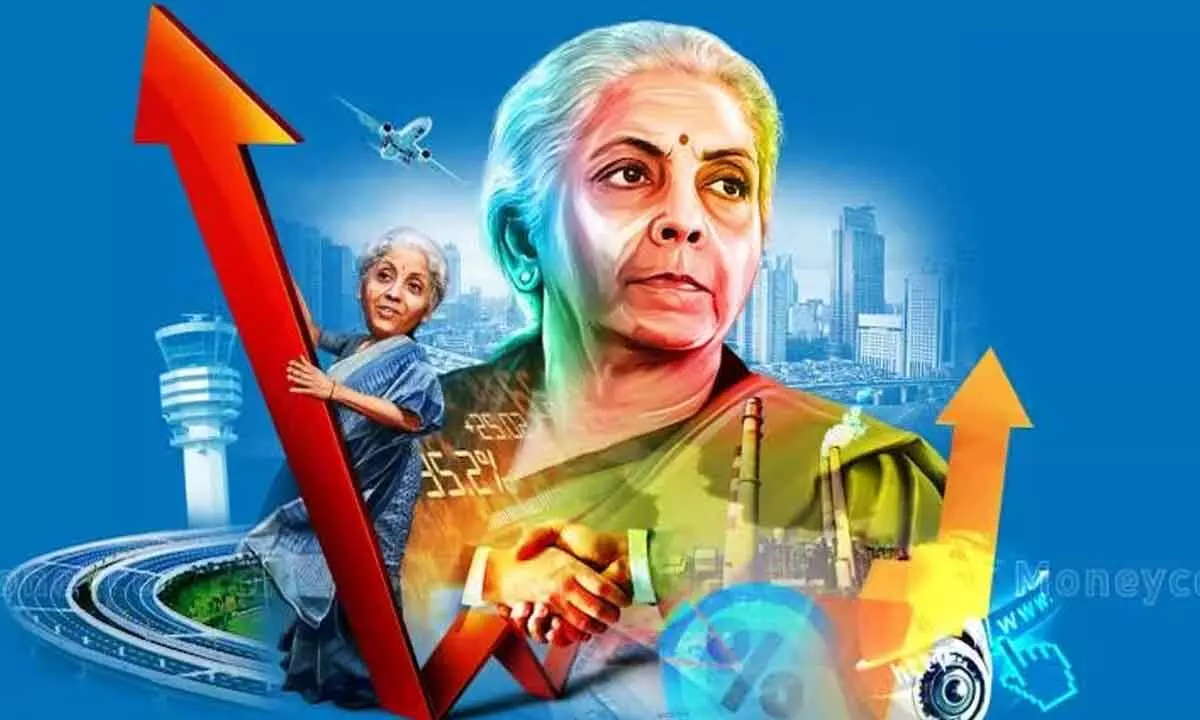Live
- A feast of music, dance and drama
- Mohan Babu denies absconding amid legal controversy
- Swift City to boost industrial growth in Bengaluru
- Allu Arjun walks out free after spending night in jail
- Congress harbours no grudge against any actor: TPCC chief
- Allu Arjun meets Upendra after release from prison, wishes for his ‘UI’ film
- Government Launches Uniform Diet Plan to Boost Student Health and Education
- Robust Security Arrangements for TSPSC Group-2 Exams in Jogulamba Gadwal
- National Lok Adalat Resolves 3387 Cases at Alampur Court
- ‘Get Set, Grow Summit 2024’ Focuses on Digital Detox for Families
Just In
Populism laced with pragmatism – despite polls


Nirmala Sitharaman, the first woman Finance Minister of India, struck all right notes in her sixth budget in a row and the last budget of Modi 2.0....
Nirmala Sitharaman, the first woman Finance Minister of India, struck all right notes in her sixth budget in a row and the last budget of Modi 2.0. Coming as it did ahead of the General Elections, the interim budget with a vote-on-account is broadly a statement on the spendings to come up in the full budget after the elections. In a confident tone, beaming with jubilation at government’s achievements and higher targets for the 2024-25 financial year, the FMlisted the achievements of the BJP-led government and laid out a road map.
In her speech – shortest at 58 minutes – that sounded like a report card, the FM did come with budget props wherever possible. She expressed the government intent and resolve through reiteration of ‘reform, perform and transform’ to make India a ‘Viksit’ (developed) nation by 2047. The FM, as expected,reached out to the major voting constituents i.e., the poor, women, youth and farmers, signalling that the full budget would go in for more welfare schemes. She spoke of social justice and the empowerment of the four segments of the population to drive the country forward.
Nevertheless, populism is tamed with pragmatism. It being the interim budget, despite elections round the corner, the Finance Minister did not defer to the wishes of taxpayers and kept the purse strings tight. In a big disappointment for them, tax rates have been kept unchanged, including those on imports. However, Sitharaman said the government would call off disputed tax demands, benefiting about 1 crore taxpayers. Besides, a few benefits to start-ups and tax exemptions expiring in March have been extended till March 2025.
While Sitharaman patiently addressed all the key sectors, she tried to balance welfare and development programmes– a hallmark of the Modi administration. She set a rather aggressive fiscal consolidation target. FY25 fiscal deficit target of 5.1% as against expectations of 5.3%. She announced that in FY24, the fiscal deficit target of 5.8% had been achieved. Accordingly, to reduce fiscal deficit, gross borrowings would not cross `14.13 lakh crore. For the FY 2023-24, gross market borrowings target was fixed at Rs 15.43 lakh crore. The private sector which is crying foul that it is being crowded out of the open market by the government will get a breather.
The Modi government’s confidence in its ability to achieve a reduction in fiscal deficit stems from better revenue mobilisation. Robust tax collections this financial year, mainly driven by direct taxes, afforded some fiscal space to the government to carry out additional spending without resorting to borrowings, while meeting the fiscal deficit target of 5.9% of the GDP for FY24.
Modi’s often emphasis on the need to rely on sustainable energy found its echo in a series of measures to meet India’s net zero emissions goal and increase the share of renewable energy in the energy mix to ensure energy security of the nation. Rooftop solarisation is targeted to help one crore households obtain up to 300 units free electricity every month.Besides Ayushman Bharat cover for ASHA and Anganwadi workers, timely and adequate finance for MSMEs,Blue Economy 2.0 with coastal aquaculture and mariculture focus etc., announcement of three major railway freight corridors is another highlight of the budget.On the whole, the budget finely spelt out NDA government’s welfare thrust, fiscal prudence and what is in store in the next full budget. Last but not least, a 11% increase proposed in capital expenditure to around Rs 11.1 lakh crore, at 3.4% of GDP (up from 3.3%), indicates the Modi government will step in as and when private investments decelerate, to keep the fiscal health of nation. BRAVO!

© 2024 Hyderabad Media House Limited/The Hans India. All rights reserved. Powered by hocalwire.com






